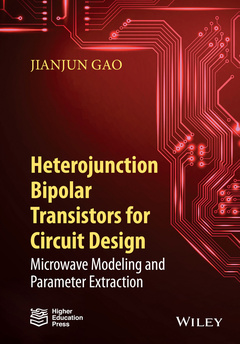Description
Heterojunction Bipolar Transistors for Circuit Design
Microwave Modeling and Parameter Extraction
Author: Gao Jianjun
Language: English
Subject for Heterojunction Bipolar Transistors for Circuit Design :
Keywords
characterization of heterojunction bipolar transistors; basic modeling techniques for semiconductor devices; basic concepts of heterojunction bipolar transistor; state-of-the-art modeling; equivalent circuit parameter extraction method; heterojunction bipolar transistors; signal and noise parameters of two-port networks; basic operation mechanisms; modeling techniques; bipolar junction transistor and heterojunction bipolar transistor; electronic circuits; circuit related modeling techniques; semic
Approximative price 151.60 €
In Print (Delivery period: 12 days).
Add to cart280 p. · 17.5x25.2 cm · Hardback
Description
/li>Contents
/li>Biography
/li>
A highly comprehensive summary on circuit related modeling techniques and parameter extraction methods for heterojunction bipolar transistors
- Heterojunction Bipolar Transistor (HBT) is one of the most important devices for microwave applications. The book details the accurate device modeling for HBTs and high level IC design using HBTs
- Provides a valuable reference to basic modeling issues and specific semiconductor device models encountered in circuit simulators, with a thorough reference list at the end of each chapter for onward learning
- Offers an overview on modeling techniques and parameter extraction methods for heterojunction bipolar transistors focusing on circuit simulation and design
- Presents electrical/RF engineering-related theory and tools and include equivalent circuits and their matrix descriptions, noise, small and large signal analysis methods
Contents
About the Author ix
Preface xi
Acknowledgments xiii
Acknowledgments (list of sources) xv
Nomenclature xvii
1 Introduction 1
1.1 Overview of Heterojunction Bipolar Transistors 1
1.2 Modeling and Measurement for HBT 5
1.3 Organization of This Book 7
References 7
2 Basic Concept of Microwave Device Modeling 9
2.1 Signal Parameters 10
2.1.1 Low-Frequency Parameters 11
2.1.2 S-Parameters 16
2.2 Representation of Noisy Two-Port Network 21
2.2.1 Noise Matrix 21
2.2.2 Noise Parameters 24
2.3 Basic Circuit Elements 25
2.3.1 Resistance 25
2.3.2 Capacitance 26
2.3.3 Inductance 29
2.3.4 Controlled Sources 31
2.3.5 Ideal Transmission Line 34
2.4 π- and T-Type Networks 37
2.4.1 T-Type Network 37
2.4.2 π-Type Network 39
2.4.3 Relationship between π- and T-Type Networks 40
2.5 Deembedding Method 43
2.5.1 Parallel Deembedding 43
2.5.2 Series Deembedding 44
2.5.3 Cascading Deembedding 45
2.6 Basic Methods of Parameter Extraction 46
2.6.1 Determination of Capacitance 46
2.6.2 Determination of Inductance 47
2.6.3 Determination of Resistance 49
2.7 Summary 50
References 50
3 Modeling and Parameter Extraction Methods of Bipolar Junction Transistor 51
3.1 PN Junction 52
3.2 PN Junction Diode 55
3.2.1 Basic Concept 55
3.2.2 Equivalent Circuit Model 59
3.2.3 Determination of Model Parameters 65
3.3 BJT Physical Operation 67
3.3.1 Device Structure 68
3.3.2 The Modes of Operation 70
3.3.3 Base-Width Modulation 75
3.3.4 High Injection and Current Crowding 77
3.4 Equivalent Circuit Model 78
3.4.1 E–M Model 78
3.4.2 G–P Model 83
3.4.3 Noise Model 86
3.5 Microwave Performance 87
3.5.1 Transition Frequency 88
3.5.2 Common-Emitter Configuration 90
3.5.3 Common-Base Configuration 91
3.5.4 Common-Collector Configuration 92
3.5.5 Summary and Comparisons 93
3.6 Summary 94
References 94
4 Basic Principle of HBT 95
4.1 Semiconductor Heterojunction 96
4.2 HBT Device 101
4.2.1 GaAs HBT 102
4.2.2 InP HBT 110
4.3 Summary 115
References 115
5 Small-Signal Modeling and Parameter Extraction of HBT 117
5.1 Small-Signal Circuit Model 118
5.1.1 Pad Structure 118
5.1.2 T-Type Circuit Model 120
5.1.3 π-Type Circuit Model 122
5.1.4 Unilateral Power Gain 124
5.1.5 fT and fmax 126
5.2 HBT Device Structure 127
5.3 Extraction Method of PAD Capacitances 128
5.3.1 Open Test Structure Method 128
5.3.2 Pinch-Off Method 129
5.4 Extraction Method of Extrinsic Inductances 132
5.4.1 Short Test Structure Method 132
5.4.2 Open-Collector Method 134
5.5 Extraction Method of Extrinsic Resistance 137
5.5.1 Z Parameter Method 137
5.5.2 Cold-HBT Method 138
5.5.3 Open-Collector Method 143
5.6 Extraction Method of Intrinsic Resistance 146
5.6.1 Direct Extraction Method 146
5.6.2 Hybrid Method 154
5.7 Semianalysis Method 159
5.8 Summary 163
References 166
6 Large-Signal Equivalent Circuit Modeling of HBT 169
6.1 Linear and Nonlinear 170
6.1.1 Definition 170
6.1.2 Nonlinear Lumped Elements 172
6.2 Large Signal and Small Signal 177
6.3 Thermal Resistance 177
6.3.1 Definition 179
6.3.2 Equivalent Circuit Model 183
6.3.3 Determination of Thermal Resistance 187
6.4 Nonlinear HBT Modeling 194
6.4.1 VBIC Model 194
6.4.2 Agilent Model 197
6.4.3 Macromodeling Method 202
6.5 Summary 204
References 204
7 Microwave Noise Modeling and Parameter Extraction Technique for HBTs 207
7.1 Noise Equivalent Circuit Model 208
7.2 Derivation of Noise Parameters 210
7.3 Noise Parameter Extraction Methods 219
7.3.1 Tuner-Based Extraction Method 220
7.3.2 Noise Parameters Based on Noise Figure Measurement 222
7.4 Common Base, Emitter, and Collector Configurations 230
7.4.1 Signal Parameter Relationships 231
7.4.2 Noise Parameter Relationships 236
7.5 Summary 243
References 243
8 SiGe HBT Modeling and Parameter Extraction 245
8.1 Introduction 245
8.2 Small-Signal Model 246
8.3 Large-Signal Model 251
8.3.1 HICUM 251
8.3.2 MEXTRAM Equivalent Circuit Model 253
8.4 Summary 255
References 255
Index 000
Jianjun Gao, Professor, School of information Science and Technology, East China Normal University, Shanghai, P.R.China
Jianjun Gao received his Ph.D. from Tsinghua University, in 1999. In 2003, he joined the Institute for High-Frequency and Semiconductor System Technologies, Berlin University of Technology, Germany, as a research associate working on the InP HBT modeling and circuit design for high speed optical communication. In 2004, he joined the Electronics Engineering Department, Carleton University, Canada, as Post-doctoral Fellow working on the semiconductor neural network modeling technique. Since 2007, he has been at East China Normal University, Shanghai. His main areas of research are characterization, modeling and wafer measurement of microwave semiconductor devices, optoelectronics devices and high-speed integrated circuits for radio frequency and optical communication.




